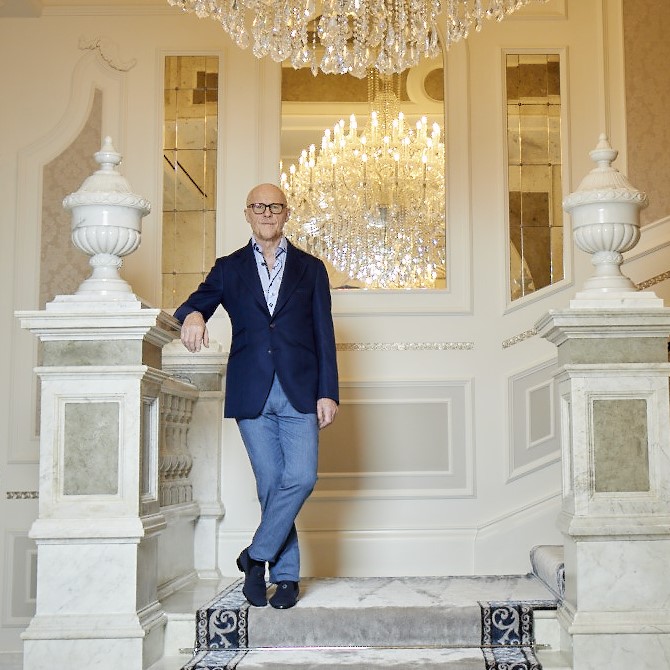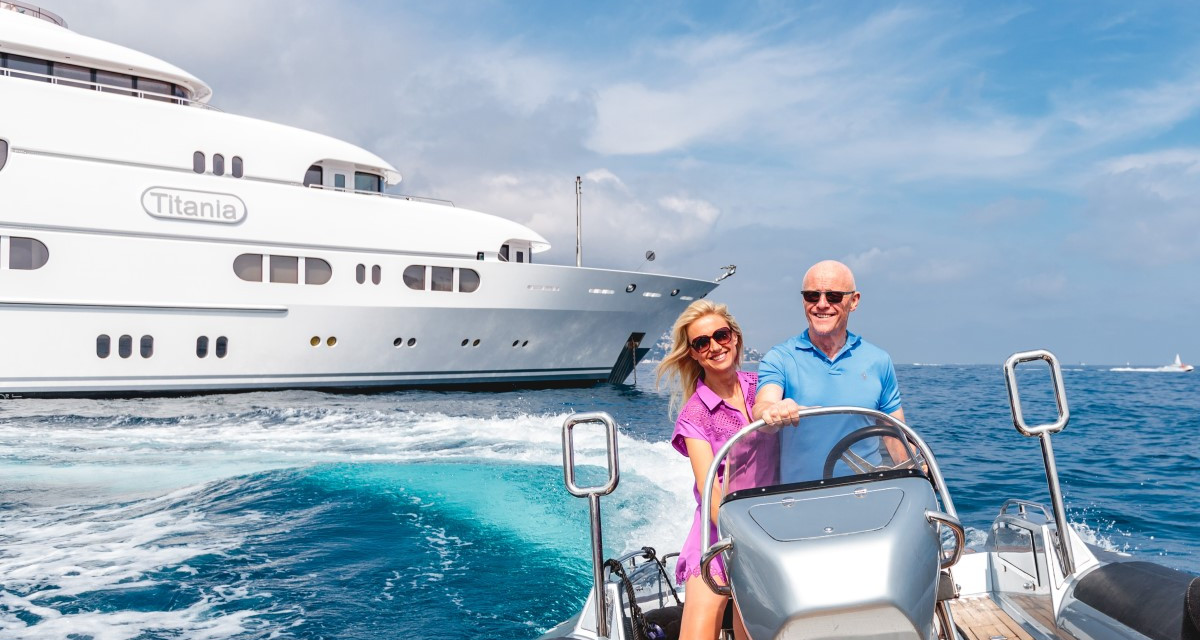On the path to making his fortune, billionaire businessman and philanthropist John Caudwell has endured devastating personal lows. In an emotional interview to mark the release of his new autobiography, he reflects on fatherhood, his new landmark development in Mayfair and the secret to making the perfect chip
Words: Jonathan Whiley
Amid the palatial surroundings of Britain’s most expensive home, the voice of billionaire John Caudwell begins to waver – and then breaks with emotion. Revisiting his life for his recently released autobiography, Love, Pain & Money, has been – he says – “very, very emotional.”
During our 90-minute interview at his Mayfair mansion (more than twice the size of the Royal Albert Hall with eight floors and a strict shoes off on entry policy), tears will be shed several times. At one stage his assistant passes round a box of tissues.
His memoir is a fascinating, revealing and emotionally-charged read. At its heart is a rags-to-riches story; of growing up in “smoky old Stoke” [on-Trent] and one day – at a car auction in 1987 – spotting a mobile phone in a large suitcase. At a time when only one in every thousand Brits owned a mobile, John saw an opportunity. It paid off handsomely; having founded retailer Phones4u, he sold the business for a cool £1.46 billion in 2006.
The 70-year-old’s life also features devastating personal lows. As a child he was shamed by his own father for wetting the bed (he was nicknamed “wee-wee”) and bullied at school (he was decorated with cuts and bruises – one day half a brick split his head open).
In later life, he had to contend with watching his first wife Kate undergo electroconvulsive therapy for postnatal depression, then later – unconnected – his decision to have an affair (“I’m not proud of what I did”) and the pain of not meeting his daughter, Scarlett, (whom he had with violinist Jane Burgess) until she was seven.
“Not seeing Scarlett for seven years was wrong of me,” he says when I bring this up. “It was a delicate moment, being introduced to your dad at that age… we built her into the family gradually and she became a full part very quickly. I’m delighted I made that decision, and somewhat saddened that I didn’t make the decision earlier.” His voice begins to crack with emotion. “But at least I did the right thing eventually.”
He says he would never change the difficult times. “I think they helped to make me stronger and better. More a humanitarian probably. Probably a better father. I buried them… I had forgotten the emotion and the pain.”
The hardest memory to revisit was connected with Rufus, John’s first-born son. In 2005, Rufus collapsed suddenly – aged 10 – at Broughton Hall, John’s manor house in Staffordshire. “That was unbelievably painful,” he says today. “But not as painful as it was going to become. You think he’s had a bit of a breakdown of some sort, that we will take him to see the doctor and in a week he will be fine. But he wasn’t. We went from a catastrophic situation to worse and worse… I mean now I could burst into tears about it, because it was horrific.”
Rufus became agoraphobic and incredibly anxious; at one stage terrified of everything from his pulse to his breathing. With his own 13-year relationship with second wife Claire [Johnson] coming to an end and embroiled in a legal case with a former business partner, John admits “his world was caving in.” “For a few months, everything went black, and finally, I understood those desperate moments in which people decide to end their lives. But I knew I had to fight on… I couldn’t give up on Rufus.”
Rufus was diagnosed with Bartonella – a co-infection of Lyme disease that can cause serious neurological conditions. John and almost all of his immediate family discovered they had Lyme Disease too; albeit in a lesser form. “Instead of being able to cycle for 10 hours a day – I can easily cycle 10 hours a day, no problem at all – I would hit this horrible fatigue even if I cycled for two hours… I had mild flu-like symptoms; a burning in my eyes, my scalp feeling tight on my head.”
Rufus was later diagnosed with PANS/PANDAS – an autoimmune condition – and has written his own moving chapter in the book. “When Rufus says ‘people think that I’m defined by dad’s success but really he’s defined my illness, that really is poignant,” says John, his voice wavering once more. “Because I was… utterly defined.”
Fatherhood is something of a defining theme. John enjoyed a close relationship with his mother (who died earlier this year, aged 98), but didn’t feel the love from his father who passed away when John was 19. Did their relationship change his own approach? (he is a father to six with another girl expected in March).
“Oh massively… everything my dad did wrong, it taught me what I must never do. I’m not a smothering father, but the love and support is always there. I would never change the experience of my father – it was sad at the time and I’m sad when I think back to it, but I would never change it because how would I learn that life lesson? He wasn’t a bad person. He was scarred from the war and I was a devilish child. I was my own man at five-years-old.”

A “full-blown street urchin” he was trading in toys aged four and a regular smoker at the age of seven. He also tells me about encountering paedophiles on a day-to-day basis. “I was sitting in an empty cinema when I was seven and a guy sat next to me and put his hand on my leg. I knew about everything at seven and I knew what he was up to.” Did he tell his mum? “No point,” he says. “Because it was every day. That is a massive exaggeration, but paedophiles were everywhere. Apparently at Hanley Park [in Stoke] there was a guy that would give you half a crown if you gave him a blowjob.”
Street savvy and driven, the road to becoming a billionaire was defined by a long and arduous work schedule and a feeling – even in his twenties – that time was running out. Both his father and grandfather died in their early 50s. “I couldn’t really see how I was going to get past 50, no matter what,” he says. “But I was really adventurous; lived a dangerous life. All my friends said I would be dead before I was 17 because of the way I used to ride motorbikes. Also my diet was dreadful… I used to have bags of pork scratchings at the pub with pints of beer and love it. Still would! But I’ve modified dramatically.”
“Nutritionally-obsessed”, John takes more than 20 vitamins and supplements a day, rarely eats anything unless it’s organic and has had the same salad for lunch for the past three years. However, as a glutton (his words), there are weaknesses. He can’t resist a Milky Bar and loves KFC’s spicy wings. “They are utterly five-star,” he says. “I can’t think of anything I would prefer to eat. I allow myself that indulgence once a month… better than going to any Michelin-starred restaurant on the planet.”
A massive foodie, he spends hours perfecting a dish and says he makes the best chips in town. “You want an element of really nice oil to have soaked into the chip. Otherwise you get a very dry chip. The most important thing is getting a golden crispy outside and fluffy soft inside.”
A lighter moment in the book is a “chip-off” between John and his friend David Lewis of Sunseeker with 13 guests and 13 chips. Chip A – John’s – came out on top.
There are celebrity encounters too; meeting Mandela (“he was amazing, a great guy”), hosting Margaret Thatcher at Broughton Hall (“I think she was the most amazing Prime Minister I’ve ever known – I wouldn’t be living in Britain today without her”), and dinner with President Gorbachev in Moscow (a charity auction prize in which he was joined by Hugh Grant, who matched his significant donation).
John’s charitable endeavours take up a significant amount of his time and money. He set up Caudwell Children in 2000 to change the future of disabled and autistic children (it will receive all proceeds from his book) and in light of his experience with Rufus, set up Caudwell LymeCo to fund research into Lyme disease.
Despite time pressures, he has just founded another charity – Caudwell Youth – providing one-to-one mentors for 11-25 year-olds who may be vulnerable. “I need to work less and be less active, but when a proposition like that comes my way it touches my heart,” he says.
When did he become so emotional? It’s a refreshing quality; as is his candid, down-to-earth nature. “I think I’ve developed it from helping all these children, from Rufus’s illness, the breakdown of my relationships.”
John has also signed up to The Giving Pledge – created by Bill Gates and Warren Buffett for the world’s wealthiest people and is committed to donating at least 70 per cent of his to philanthropic causes.
“I don’t understand why people who are very, very wealthy don’t join,” he says. “And I don’t understand people who don’t do charitable work… once you have made wealth like I’ve made, what is the point of hogging that? I don’t want to leave it to my children. I want them to be successful and happy in their own right and not become trust fund babies.”
With the largest private ballroom after Buckingham Palace, John’s Mayfair mansion allows him and partner – former Olympic cyclist Modesta Vzesniauskaite – to host gala dinners and fundraising balls for their charitable causes.
“The more I looked at Mayfair, I thought it had real character. There are some dreadful buildings in Mayfair… but this area, which I call Mayfair village, is really stunning. When I started looking 15-20 years ago, Mayfair was not in a very good place. I then bought the site and this house [in 2012] and started appreciating Mayfair and talked Mayfair up… now it’s where it should be; at the top of the Caudopoly board. We designed our Caudopoly board and you will be pleased to know that 1 Mayfair is the most expensive property on the board.”
1 Mayfair is the landmark project by John and New York-based Robert A.M. Stern Architects with the creation of 29 exceptional homes; thought to be London’s most expensive ever residential building.
“The number one criteria is that I build something that is the most prestigious place to live in the world,” says John. “My vision was grand Mayfair architecture; I wanted something that would stand the test of time. Mayfair village, where we are, is the heart of Mayfair; Mayfair is the heart of London and London is the heart of the world. I don’t think there are many people that could disagree.”
Love, Pain & Money: The Making of a Billionaire, is out now.






